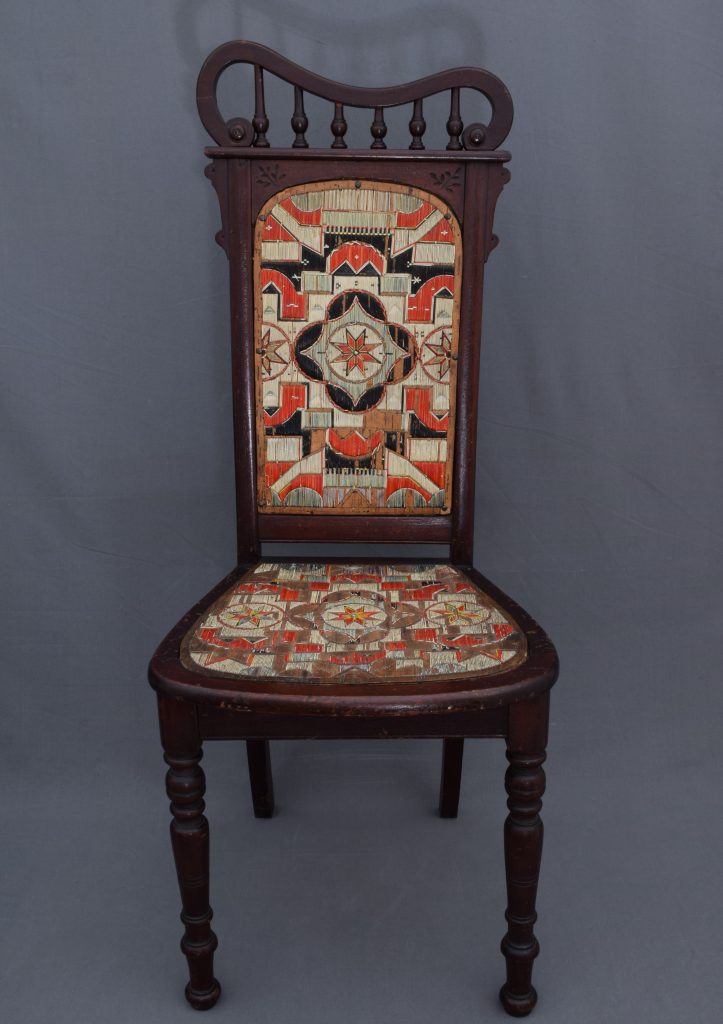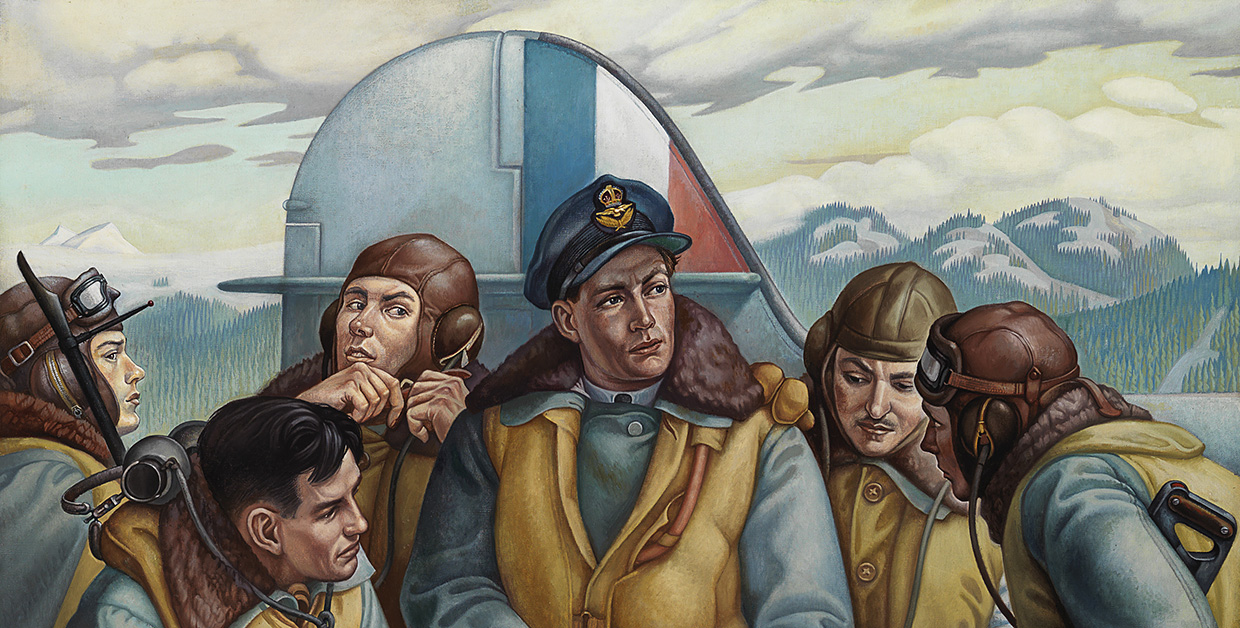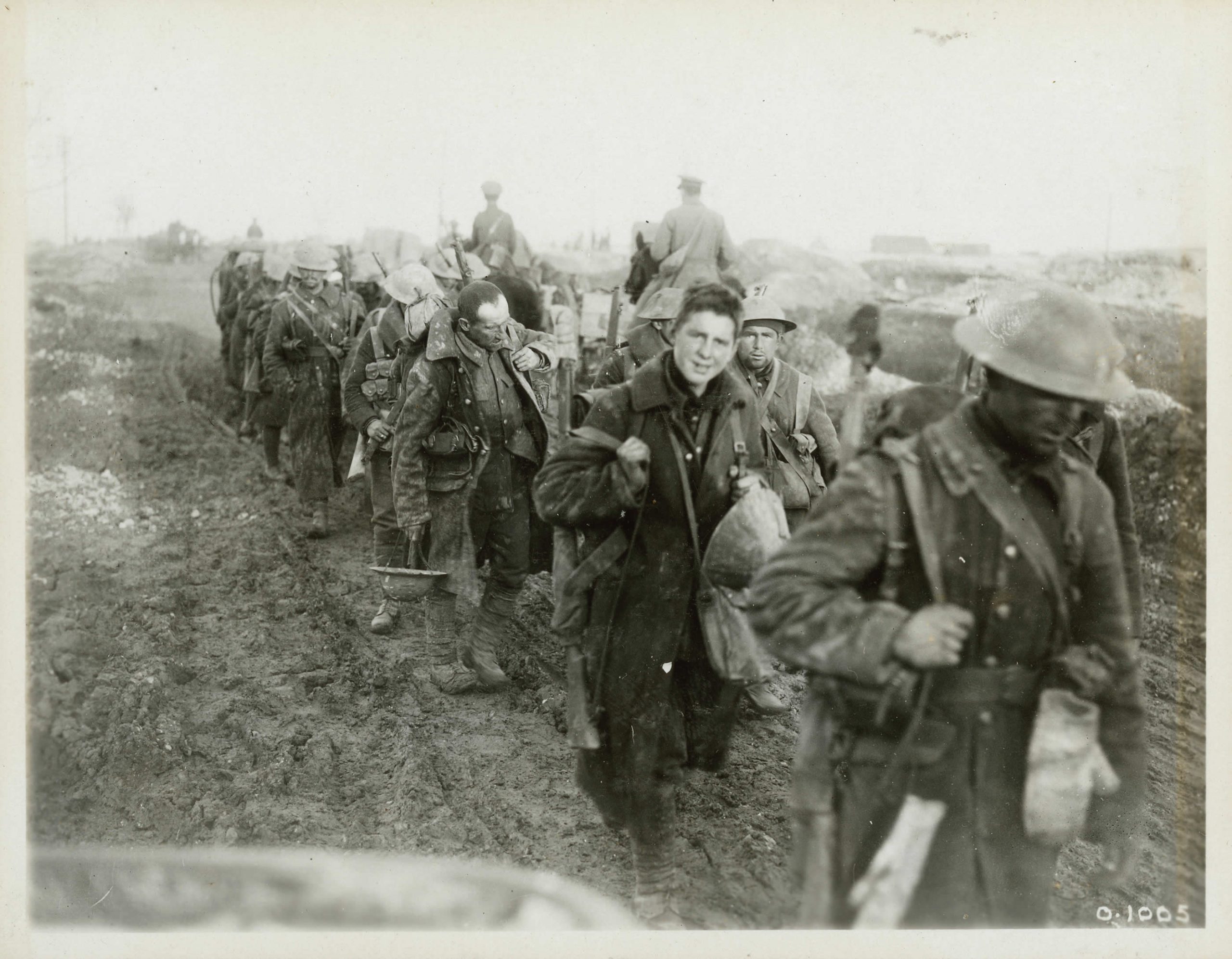From the series “Dispatches: Backgrounders in Canadian Military History”
(Note that some of the content in this series is outdated and is under review.)
Age is taking an inevitable but heavy toll on the generation of Canadians who remember the two world wars. As it does, the Canadian War Museum’s war art collections of 13,000 works increasingly provide a link to the conflicts from the perspective of those who witnessed them. While, to a certain extent, the paintings act as illustration, they also convey the feelings of the participants in the conflicts. This, perhaps, is their most important legacy.
There are three collections: the Canadian War Memorials of the First World War (1914-18); the Canadian War Records of the Second World War (1939-45); and the post-war Canadian Armed Forces Civilian Artist Program (1968-95). The Canadian War Memorials, the First World War art collection, consists of nearly 1,000 works by over 100 artists, more than a third of them Canadian. In part because of its wide variety, the collection is of international stature. Not only does it powerfully capture Canada’s part in this tragic ‘war to end all wars’, but it has also proven a major influence in the development of Canadian art. Much of the familiar landscape art of Canada’s celebrated Group of Seven, for example, owes its genesis to sights seen and recorded in the mud and trenches of the Western Front in France and Belgium.
The collection was the brainchild of Sir Max Aitken, later Lord Beaverbrook. Born in Canada in 1879, he made a fortune as a businessman in the country’s early years of expansion. After moving to Britain, he became financially involved in 1911 with the Daily Express, buying this newspaper outright five years later and using it as a vehicle for his ideas and to extend his influence. By this time the First World War had been ongoing for two years. While its losses had been heavy, the Canadian Corps had developed into a competent, professional force. Always a Canadian at heart, Beaverbrook’s genuine nationalist fervour contributed to his decision in 1916 to initiate and take personal responsibility for a project to record the war from Canada’s point of view. The result was the creation of the Canadian War Records Office.
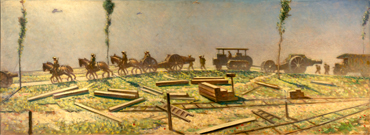
Aitken’s media interests made him ideally suited to the task of documenting the war in film, photograph, and print. His experience with a mass circulation daily paper meant he also knew what engaged people’s interests. A single event, the horrific German gas attack on the Canadians during the Second Battle of Ypres in April and May 1915, convinced him that the war should also be documented by art. The event was not photographed. So, in November 1916, Aitken’s new organization, the Canadian War Memorials Fund, a spin-off from the Canadian War Records Office, commissioned a huge 3.7 x 6-metre painting from British society artist Richard Jack. The success of this venture, combined with the prevailing belief at that time that the life-span of photographs was no more than twenty-five years, contributed to Aitken’s decision to commission more artists to record Canada’s war. He and his art advisor, Paul Konody, art critic at the Observer newspaper, thought in terms of major commissions. However, they were also responsive to the idea that artists should spend time on the battlefield making sketches that would be of archival value, and which in time might be turned into larger works.
While supportive of Beaverbrook’s initiative, Sir Edmund Walker, Chairman of the Board of Trustees of the National Gallery of Canada, and Eric Brown, the institution’s director, sought to ensure that the war art program truly reflected Canada’s role in the conflict. They worried that the program recommended too many commissions for British artists. Walker corresponded with Beaverbrook concerning the employment of Canadian artists, an exchange that resulted in the establishment of the Canadian War Artists Advisory Committee. In 1917, Beaverbrook hired the future Group of Seven painter, A.Y. Jackson, then a soldier recovering from wounds he had received in June 1916. Jackson’s seemingly cavalier reaction to the front after his return there as a war artist belies the tragic content of many of his painting: “same old war…same old soldiers sticking it out, fed up but cheerful and doing impossible things, same old mud and shell holes.”
In 1918, Walker was instrumental in ensuring official commissions for four more Canadians. One of them, Frederick Varley, another future member of the Group of Seven, was attached to the Canadian Corps in August 1918, when it began its advance from Amiens, France to Mons, Belgium during the Canadian-led offensives, known as ‘The Hundred Days’, which ended the war. By then, 60,000 Canadians had been killed of the over 620,000 enlisted. Varley memorialized what he saw in some of the bleakest, most moving, and starkly vivid works to come out of the war on any side.
Walker and Brown of the Canadian War Artists Advisory Committee also included two other aspects of the conflict in the artistic record of the war: women and the home front. Arthur Lismer, a future Group of Seven painter, created memorable images of Halifax, Nova Scotia in wartime, while another future member, Frank Johnston, worked for several months documenting pilot training at various bases in Ontario. For the most part, women artists used women wartime workers as subjects. Women’s work itself was transformed, as thousands undertook tasks previously performed only by men.
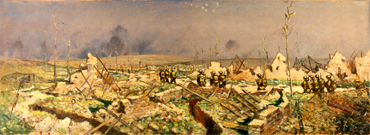
As the war drew to a close, Walker’s influence led to planning for a special building in Ottawa to house the art. Simultaneously, Beaverbrook announced the existence of his own commissioned designs for a monumental war memorial art gallery, also to be constructed in the nation’s capital. A decade of lobbying by protagonists of both schemes produced neither building. Instead, Beaverbrook lost interest in the project, feeling generally that his wartime work for Canada had been under-appreciated. By default, the National Gallery was left with custody of the artwork that he had commissioned during the war.
The Second World War produced an entirely different Canadian art program. There are no huge memorial compositions focussing on destruction, tragedy, and misery. Instead, the somewhat depersonalized emphasis of most of its over 5,000 small paintings is on the locations, events, machinery, and personnel of Canada’s war on all fronts.
Like the First World War art scheme, however, the Second World War plan depended on the energies of a committed few. The most important player was Canada’s High Commissioner to Great Britain, Vincent Massey. This time, Britain had instituted a war art program very early on, and when London’s National Gallery exhibited some of its first works in December 1939, Massey suggested Canada should institute its own project. The Department of National Defence’s response was initially one of indifference. Meanwhile, H.O. McCurry, Eric Brown’s successor as director of the National Gallery of Canada, began his own lobbying effort.
Despite Massey’s and McCurry’s initial lack of success in establishing a full-fledged program, they did make progress, and Canadians were soon producing war paintings. A number of artists had enlisted in the armed forces and, inspired by their knowledge of the First World War program, contacted McCurry to suggest they would be more useful as artists in uniform. McCurry in turn passed their offers to National Defence Headquarters. There, Colonel A.F. Duguid, director of the historical section of the general staff, proceeded to employ Private E.J. Hughes and Sapper O.N. Fisher to depict activities in the army. In England, Massey arranged for Trooper W. A. Ogilvie to be attached to Canadian military headquarters as an artist.
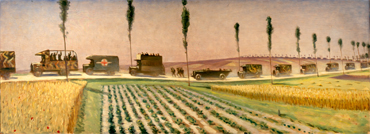
With the appointment in late 1940 of Major C.P. Stacey as the Canadian Army’s historical officer in London, Massey and McCurry acquired an important ally. One of Stacey’s first tasks was to coordinate the work of the notable English artist, Henry Lamb, who, as part of the British art program, had undertaken an assignment in 1941 to paint the Canadian army in England. Convinced that this sort of endeavour was of certain historical value, Stacey, in early 1942, was instrumental in formalizing the employment of Hughes, Fisher, and Ogilvie, and later Lawren P. Harris as war artists, and in obtaining for them the rank of second lieutenant. Despite these initiatives, not to mention the support of the Canadian art establishment as a whole, the first three years of the war were only minimally recorded.
Late in 1942, the indefatigable Massey again tried to organize an official war art program. His request made it through the bureaucracy to the desk of Prime Minister William Lyon Mackenzie King, who finally approved it. It was formally set up in January 1943, and a committee consisting of H.O. McCurry and senior military personnel from the three services ran the program from Canada. In Britain, Massey was the guiding light; officers in the services handled the mechanics of the program. Stacey, for example, continued to run the army’s official art program. It was a huge endeavour, the records of which contain hundreds of letters from service personnel, units, and newspapers requesting work or information, hundreds of notes written by staff officers regarding the movements of war artists, and file after file of war art listings, photographic records, and requests for loans.
The thirty-one officers ultimately hired as official war artists were given rank, pay, supplies, and instructions. They were divided almost evenly among the three services, and served in all the western theatres of war including Britain, Italy, Northwest Europe, and the Atlantic Ocean. The army was quick off the mark, initially having the largest number of artists in the field, followed by the air force. The navy program was the last one to be put in place. The only woman artist, twenty-three year old Molly Lamb, formerly a private in the Canadian Women’s Army Corps, was not allowed overseas until after the war in Europe had ended in May 1945. The program initially neglected the home front and, in particular, the women’s military services, which by war’s end had recruited nearly 46,000 personnel. McCurry recognized this, but not until 1944 did he hire artists like Pegi Nicol MacLeod to paint the women’s services in Ottawa.
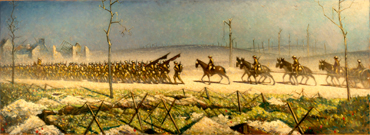
The program of work the artists followed differed very little from hat of their First World War predecessors. Moreover, the artists’ official instructions issued by the committee managing the program were tightly focussed, leaving little room for interpretation. They specified the size and quantity of their paintings as well as their subjects. For the most part, the artists were not well prepared for this new subject matter; the landscape tradition, in which they had largely been trained, had equipped them poorly for the reality of war. Accuracy was paramount, and the degree to which the artists saw this as important can be seen in their thousands of detailed small sketches of equipment, vehicles, and uniforms. Their finished oil compositions, however, reveal how well they adapted their skills to the requirements of war. In them, creativity and record are combined in images that are sensitive to both history and art.
Those of official army artist O.N. Fisher were unusually innovative. In preparation for the D-Day invasion on 6 June 1944, he strapped tiny waterproof pads of paper to his wrist. After racing up the beach from his landing craft, Fisher made rapid, on-the-spot sketches, using perfectly dry materials, of the battle unfolding around him. Later, the artist created larger watercolour paintings away from the battlefront. The time, date, location, event, and the names of the units depicted were carefully noted on the back. Historical officers attached to the same units as the artists would assess these compositions for accuracy and any breach of censorship before forwarding the pieces to London. After May 1945, the artists returned to Canada where the military provided studio space to complete a number of canvasses based on their earlier work. Despite their restrictive instructions, the new subject matter, and the dangerous surroundings, the war artists produced a remarkable legacy of the conflict. Their paintings range through a variety of styles and plumb the depths of human emotions shared by the 1.1 million who served and who witnessed the deaths of more than 42,000 of their comrades.
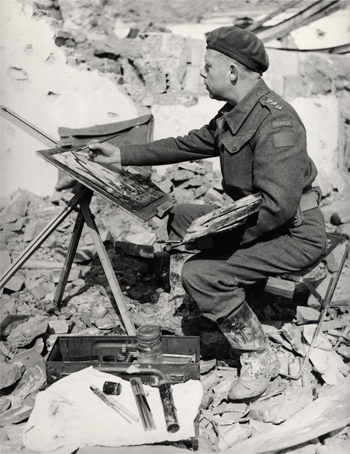
As in the case of the First World War art scheme, there was some confusion among the government agencies involved as to what to do with the works once the war was over. Although the Cabinet ordered the Canadian War Records deposited with the National Gallery in 1946, a curator for them was not appointed until 1960. The second appointee, Major R.F. Wodehouse, did much to popularize the collection. First, he documented all the works, a task that resulted in a 1968 publication, Checklist of the War Collections. That year he also initiated a joint project with the National Gallery and the Department of National Defence to record Canada’s post-war military endeavours. The Canadian Armed Forces Civilian Artist Program (CAFCAP) resulted in the commissioning of nearly 600 works of art that capture the Canadian military experience in bases across Canada and on duty in locations ranging from Cyprus and Israel to Somalia and Croatia. The program was eliminated in a 1995 budget cut.
In 1971, the gallery transferred the First and Second World War art collections, along with responsibility for CAFCAP, to the Canadian War Museum in Ottawa. Lacking extensive exhibition space, the museum has made the collections accessible through its website, and through a program of travelling exhibitions and loans. The works of war art are a unique legacy for all Canadians. Not only are they vivid depictions of military events inspired by personal experience, but they are also important elements in our nation’s art history. They constitute nothing less than a reflection of our national heritage.

